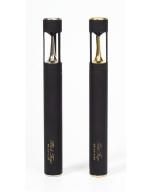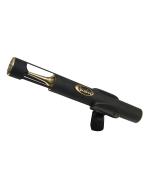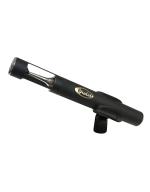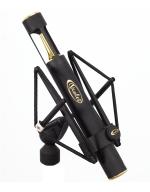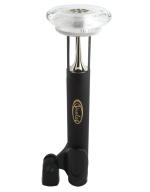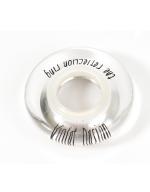The Finger
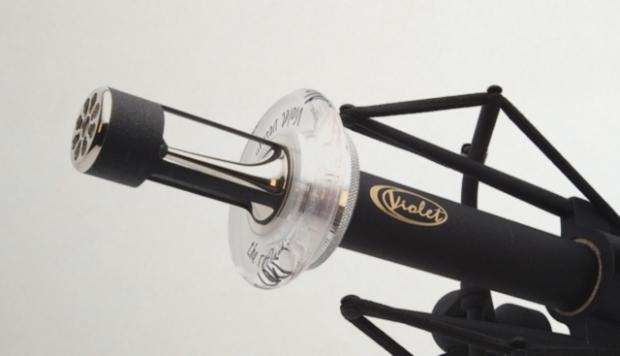
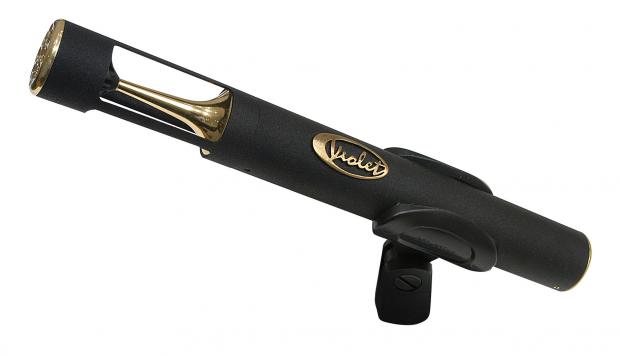
"The Finger" microphone uses medium size, single diaphragm, cardioid pattern capsule and is designed for close to neutral, very detailed sound - with smooth, transparent highs, optimal presence and natural low end response.
"The Finger" uses a single medium diaphragm transducer to provide detailed sound with smooth transparent highs, optimal presence and natural low-end response with a unidirectional polar pattern. "The Finger" has a unique body design with an integrated tapered reflector which reduces resonances, removes reflections and optimizes the microphone's cardioid polar pattern. Integrated damping of the transducer reduces stand rumble, outside infrasonic interference and mechanical shocks.
The optional and unique FRR Reflection Ring (shown here) is a reflector disc which can be positioned at the head or anywhere along the body of the microphone to alter the polar pattern, frequency response and sensitivity. Positioning the FRR at the end point of "The Finger's" reflector alters low-frequency response and adds proximity effect. The FRR can also be used to separate the front and rear sides of the capsule and to reduce reflections and reverberation from reaching the capsule. Positioning the FRR on the capsule head's top produces a polar pattern closer to a half-sphere pattern with less coloration at different angles, less proximity effect and adds sensitivity to all except high frequencies. It is even possible to use 2 FRRs, positioning one on the top of the head and one elsewhere on the body for effect. "The Finger" is available in 2 styles. "The Black Finger" has polished nickel-plated hardware and a matte black body. "The Gold Finger" has polished gold-plated hardware and a matte black body. Matched stereo pairs can be special ordered. FRR is an optional unique reflection ring accessory which is used as a tool to slightly alter directional characteristics and frequency response by positioning at different points along the microphone body.
FRR Reflection Ring is a reflector disc which can be positioned at the head or anywhere along the body of the microphone to alter the polar pattern, frequency response and sensitivity. Positioning the FRR on the top produces a polar pattern closer to a half-sphere pattern with less coloration at different angles, less proximity effect and adds sensitivity to all except high frequencies. Positioning the FRR lower of "The Finger" reflector alters low-frequency response and adds proximity effect. The FRR can also be used to separate the front and rear sides of the capsule and to reduce reflections and reverberation from reaching the capsule. FRR adds warmth, reduces acoustic feedback and protects against wrong handling of microphone. You can manipulate with sound using FRR.
Description
"The Finger" microphones are based on single diaphragm medium size electrostatic capsules. Highest quality Mylar diaphragm is sputtered with special formula coating and tensioned on precisely made back-plates, getting faster impulse transient response, minimum sound coloration, better low frequency response, and louder sound pressure level handling. Each capsule is carefully checked for all parameters and measured in an anechoic chamber for optimum of performance.
Unidirectional polar pattern effectively reduces ambient studio/stage noise and acoustic feedback on stage, keeping the frontal incidence angle optimally wide. The microphones capsule is protected with brass mesh that keeps high frequencies and sound transparency unaffected. Using of studio pop filter and/or polyurethane open cell foam windscreen is necessary for close voice applications, to protect capsule from plosive sounds, breath, pop and wind noise. Our special reflection ring gives you possibility to play with microphone directivity, proximity and other parameters and find the best sound for your concrete application. Wind screen and reflection ring are available as options.
The internal solid state pre-amplifier is based on class-A fully discrete transformer-less electronics circuit, built using the best quality, selected components. The circuits are designed under the highest audio standards and provide linear audio frequency range, high dynamics, low self-noise and very low audio distortion of all types.
"The Finger" requires quality and stable 48V phantom power. It is available from most mixing console and separate microphone pre-amplifier inputs, or from separate phantom power supply units. Some units, though rated as 48V sources, may supply inadequate or unstable phantom power, which can result in distortion and degraded performance. Please check your phantom power source under real microphone load.
Rugged microphone construction and two internal shock-mounts, separate for the capsule and for the electronics, effectively reduces hand use noise, stand rumble, outside infrasonic interference and mechanical shocks. "The Finger" is ready for use on supplied flexible microphone stand holder. It can be mounted on an external elastic suspension shock-mount for studio or special stage needs. External shock-mount is available as option.
"The Finger" is working with standard symmetric microphone cable, but we recommend to use our audiophile quality microphone cables with gold plated contact connectors to minimize external noise, signal loss and maximize contact quality. Microphone cables are available as option.
Under the special order "The Finger" microphones are available in matched pairs to provide balanced stereo recordings.
OPTIONAL ACCESSORIES
PSM - studio shock-mount
GSM - studio shock-mount
FRR - reflection ring
VMC - microphone cable
Specifications

|
Transducer type |
electrostatic |
|
Operating principle |
pressure gradient |
|
Diaphragm's active diameter |
13 mm |
|
Frequency range |
20 Hz to 20 kHz |
|
Polar pattern |
unidirectional - cardioid |
|
Output impedance |
50 ohms |
|
Rated load impedance |
1000 ohms |
|
Suggested load impedance |
>500 ohms |
|
Sensitivity at 1000 Hz into 1000 ohms load |
11 mV/Pa |
|
S/N Ratio CCIR 468-3 weighted |
71 dB |
|
S/N Ratio DIN/IEC 651 A-weighted |
82 dB-A |
|
Equivalent noise level DIN/IEC A-weighted |
12 dB-A |
|
Maximum SPL for 0.5% THD at 1000 ohm load |
140 dB |
|
Dynamic range of the internal preamplifier |
128 dB |
|
Phantom powering voltage on pins #2 & #3 of XLR |
+48 V (+/-4 V) |
|
Current consumption |
<2 mA |
|
Output connector |
3-pin XLR male, gold plated contacts |
|
Dimensions |
207 mm length x 24 mm shaft diameter, 200 g |
Review
Artists
"I tried The Finger as a spot mic on a piano and it was truly unique - slightly darker and way more interesting than a normal pencil mic."
Joe Barresi
Record Engineer/Producer
(Kyuss, The Melvins, Tomahawk, L7, The Jesus Lizard)
"I bought Violet's 'Black Finger' and it is now a permanent fixture, set up in my studio to mic an upright Bass."
Randy Kohrs
Artist/Producer/Engineer
"The Black Finger has been great on hi hat and all kinds of percussion overdubs. I've also used it on acoustic guitar with great success."
John Paterno
Producer / Mixer / Engineer
(Bonnie Raitt, Faith Hill, Joan Osborne, Los Lobos)
Applications
"The Finger" microphones are designed for very wide applications, including ambient, musical instrument and vocal needs. Musical instruments include drums, piano, guitars, percussion, bowed strings, and many other instruments. Vocals include choir and distanced lead vocal applications. The microphones can be successfully used in recording studio, in professional sound reinforcement systems and installed sound systems, broadcast and TV studios, in movie and video industry, project studios and home recording, and many other applications.
"The Finger" microphone suits a wide range of studio and stage situations. It is ideal for capturing vocals, speech, choir, and musical instruments as well as orchestral and most other sound sources. It is an excellent choice for broadcast radio and television, film production, sound reinforcement and other professional applications. In the home studio where there are generally fewer microphones available, it offers superb performance giving it outstanding value. Use of a studio pop filter and/or polyurethane open-cell foam windscreen is necessary for close voice applications, to protect the capsule from plosive sounds and breath, pop or wind noise. Matched stereo or surround sets can be special ordered to provide balanced recordings.
PIANO "The Finger" gives excellent results on piano. Use one for upper side and other on bass side of piano for stereo recording. There are many methods with close miking, distance miking and combined miking. The result depends highly on piano player and instrument individuality and room's acoustics. The right microphone placement is the most important factor. The best method is to find it by your own ear - go and listen.
ACOUSTIC GUITARS "The Finger" is giving excellent results on all types of acoustic guitars. Right placement is the most important factor again. We recommend beginning with facing the microphone to guitar's neck, where it joins body, in some 10 cm distance from it. Use a pair or more microphones for stereo recording.
DRUMS "The Finger's" fast impulse transient response, crystal clear highs and loud SPL handling make it excellent for the drums recording, especially for overhead, hi-hat and snare drum. The advisable distance is 40 to 100 cm on overhead, 20 to 40 cm from hi-hat, and 10 to 20 cm from snare drum rim, try different positions and angles. A bigger distance will add more air, environment and naturalness. A smaller distance will increase the low frequencies and separation from other sound sources. Use a pair on overhead for stereo recording.
PERCUSSIONS Like the drum recording "The Finger" microphone gives transparent, clean and real results in most percussion recording. The distance of 30 cm is the best to start. Closer distance will add more details, tone and separation. Larger distance will add room ambience, naturalness and blending with other instruments.
CHOIR The smooth, natural tone of "The Finger" is excellent for choir recording. Start with placing microphone in some 2 to 4 m distance in front of the choir and try to find the best location. Go and listen. Use 2 or more microphones for stereo recording. Room acoustics is one of the most important factor in choir recording. Many case separate distanced microphones for room acoustics are giving the best result.
VOCALS "The Finger" is great for distanced lead vocal applications. Use it in 50 to 150 cm distance to get the best results. Microphones capsule is very opened, this case using of foam windscreen can be necessary to protect capsule from breath, pop and wind noises and to reduce plosive sounds. Use pop-filter in studio.
BOWED STRINGS "The Finger" is an excellent choice for recording all kinds of bowed string instruments. The distance of 25 to 40 cm above the instrument bridge is preferable for violin and viola. The distance of 10 to 20 cm in front of bridge is right for double bass or cello.
